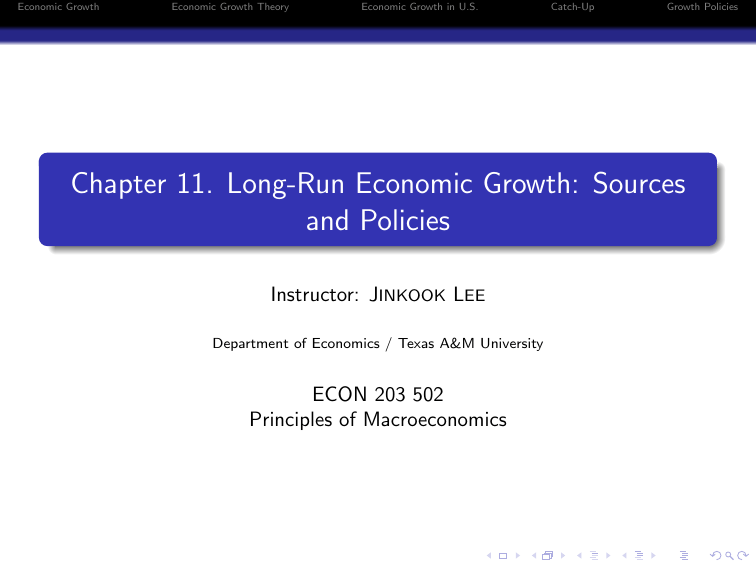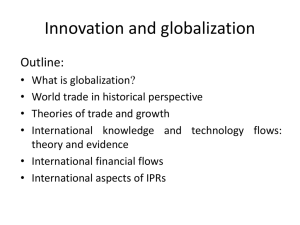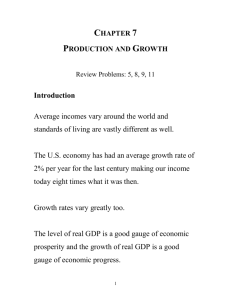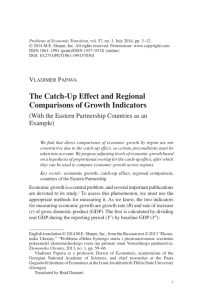Chapter 11. Long-Run Economic Growth
advertisement

Economic Growth Economic Growth Theory Economic Growth in U.S. Catch-Up Growth Policies Chapter 11. Long-Run Economic Growth: Sources and Policies Instructor: JINKOOK LEE Department of Economics / Texas A&M University ECON 203 502 Principles of Macroeconomics Economic Growth Economic Growth Theory Economic Growth in U.S. Catch-Up Growth Policies Economic Growth from 1,000,000 B.C. to the Present No sustained economic growth occurred between 1,000,000 B.C. and 1300 A.D. Industrial Revolution: The application of mechanical power to the production of goods, beginning in England around 1750. Following the Industrial Revolution, other countries (U.S., France, and Germany) experienced long-run economic growth with sustained increases in real GDP per capita. This eventually raised living standards in those countries to the high levels of today. Economic Growth Economic Growth Theory Economic Growth in U.S. Catch-Up Growth Policies Economic Growth from 1,000,000 B.C. to the Present Average Annual Growth Rates for the World Economy World economic growth was essentially zero in the years before 1300 It was very slow before 1800. The Industrial Revolution made possible the sustained increases in real GDP per capita. Economic Growth Economic Growth Theory Economic Growth in U.S. Catch-Up Growth Policies Factors Which Affect Economic Growth Economic growth model: A model that explains growth rates in real GDP per capita over the long run. Labor productivity: The quantity of goods and services that can be produced by one worker or by one hour of work. Economists believe two key factors determine labor productivity: The quantity of capital per hour worked The level of technology The economic growth model focuses on changes in these factors to explain changes in real GDP per capita. Technological change: A change in the quantity of output a firm can produce using a given quantity of inputs. Economic Growth Economic Growth Theory Economic Growth in U.S. Catch-Up Growth Policies Per-worker Production Function Per-worker production function: The relationship between real GDP per hour worked and capital per hour worked, holding the level of technology constant. Economic Growth Economic Growth Theory Economic Growth in U.S. Catch-Up Growth Policies Per-worker Production Function Increases in capital per hour worked increase output per hour worked but at a diminishing rate. At very high levels of capital per hour worked, further increases in capital per hour worked will not result in any increase in real GDP per hour worked. This effect results from the law of diminishing returns Law of Diminishing Returns: As we add more of one input, output increases by smaller additional amounts. Economic Growth Economic Growth Theory Economic Growth in U.S. Catch-Up Growth Policies Technological Change: The Key to Sustaining Economic Growth Technological change shifts up the production function It allows more output per hour worked with the same amount of capital per hour worked. Economic Growth Economic Growth Theory Economic Growth in U.S. Catch-Up Growth Policies Technological Change: The Key to Sustaining Economic Growth Along Production function1 with $50,000 in capital per hour worked, the economy can produce $575 in real GDP per hour worked. An increase in technology that shifts the economy to Production function2 makes it possible to produce $675 in real GDP per hour worked with the same level of capital per hour worked. In the long run, a country will experience an increasing standard of living only if it experiences continuing technological change. Economic Growth Economic Growth Theory Economic Growth in U.S. Catch-Up Growth Policies Economic Growth in the United States since 1950 Average Annual Growth Rates in Real GDP per Hour Worked in the United States The growth rate in the United States increased from 1800 through the mid-1970s. Then, for more than 20 years, growth slowed before increasing again in the mid-1990s. Economic Growth Economic Growth Theory Economic Growth in U.S. Catch-Up Growth Policies Economic Growth in the United States since 1950 Can the United States Maintain High Rates of Productivity Growth? Some economists argue that the development of a “new economy” based on information technology caused the higher productivity growth that began in the mid-1990s, and many expect it to continue. Others are skeptical, arguing that by the early 2000s, innovations in information and communications technology were having a greater effect on consumer products than on labor productivity. Economic Growth Economic Growth Theory Economic Growth in U.S. Catch-Up Growth Policies Catch-up: Sometimes, but Not Always Catch-up: The prediction that the level of GDP per capita in poor countries will grow faster than in rich countries. According to the economic growth model, Countries that start with lower levels of real GDP per capita should grow faster than countries that start with higher levels of real GDP per capita. Economic Growth Economic Growth Theory Economic Growth in U.S. Catch-Up Growth Policies There Has Been Catch-up among High-Income Countries Countries such as Taiwan, Korea, and Singapore that had the lowest incomes in 1960 grew the fastest between 1960 and 2009. Countries such as Switzerland and the United States that had the highest incomes in 1960 grew the slowest. Economic Growth Economic Growth Theory Economic Growth in U.S. Catch-Up Growth Policies Most of the World Has Not Been Catching Up Some countries such as Niger, Madagascar, actually experienced negative economic growth. Some middle-income countries such as Venezuela, hardly grew between 1960 and 2009. Others such as Israel, experienced significant growth. Economic Growth Economic Growth Theory Economic Growth in U.S. Catch-Up Growth Policies Why Have Not Most Western European Countries Caught Up to the United States? The blue (red) bars show real GDP per capita in 1990 (in 2010) relative to the United States. In each case, relative levels of real GDP per capita are lower in 2010 than they were in 1990, which means that these countries have ceased catching up to the United States. Economic Growth Economic Growth Theory Economic Growth in U.S. Catch-Up Growth Policies Why Have Not Most Western European Countries Caught Up to the United States? 1 The level of legal protection of investors is relatively high in U.S. financial markets, which encourages both U.S. and foreign investors to buy stocks and bonds issued by U.S. firms. 2 The volume of trading in U.S. financial markets ensures that investors will be able to quickly sell the stocks and bonds they buy. 3 This liquidity serves to attract investors to U.S. markets. 4 The ability of venture capital firms to finance technology-driven “start-up” firms may be giving the United States an advantage in bringing new products and new processes to market. Economic Growth Economic Growth Theory Economic Growth in U.S. Catch-Up Growth Policies Enhancing Property Rights and the Rule of Law A market system cannot work well unless property rights are enforced. In many developing countries, the rule of law and property rights are undermined by government corruption. it is hard for an entrepreneur to obtain a permit to start a business without paying bribes, often to several different government officials. Along those lines, there is some hope for reform movements that aim to reduce corruption in developing countries today. Economic Growth Economic Growth Theory Economic Growth in U.S. Catch-Up Growth Policies Improving Health and Education As people’s health improves and they become stronger and less susceptible to disease, they also become more productive. Recent initiatives in developing countries to increase vaccinations against infectious diseases, to improve access to treated water, and to improve sanitation have begun to reduce rates of illness and death. The rising incomes that result from government subsidies for education can lessen the brain drain, which refers to highly educated and successful individuals leaving developing countries for high-income countries. Economic Growth Economic Growth Theory Economic Growth in U.S. Catch-Up Growth Policies Promoting Technological Change For developing countries, the easiest way to gain access to technology is through foreign direct investment, where foreign firms are allowed to build new facilities or to buy domestic firms. In high-income countries, governments can aid the growth of technology by providing grants and tax breaks to universities and firms undertaking research and development. Economic Growth Economic Growth Theory Economic Growth in U.S. Catch-Up Growth Policies Promoting Saving and Investment Saving and investing will increase the equilibrium level of loanable funds and may increase the level of real GDP per capita. Governments can increase incentives for firms to engage in investment in physical capital by using investment tax credits, which allow firms to deduct from their taxes some fraction of the funds they have spent on investment, thereby increasing its after-tax return.







